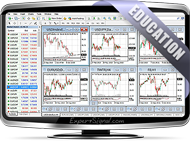Moving Averages (MAs)
◙ Primary Use: Evaluating Market Trends and Spotting Reversals
◙ Trading: Spotting trend reversals (MA Crossovers)
◙ Combination: Confirming trends when combined with other indicators (RSI, ADX)
◙ Standard Settings: 10-period, 21-period, 30-period, 50-period, 200-period MAs
![]() Introduction to Moving Averages
Introduction to Moving Averages
Moving Averages (MAs) are foundational tools in technical analysis, offering a simple yet effective way to smooth price data and filter out market noise. By comparing an asset’s price to its moving average—such as a 50-day MA—traders can quickly assess whether the asset is trending or potentially overbought/oversold.
Key Benefits of Using MAs in Trading
-
Smooth out market noise for clearer trend direction
-
Work across all timeframes and markets (stocks, forex, commodities, etc.)
-
Can serve as a confirmation tool when used with other indicators (e.g., RSI, ADX)
-
Often used in automated trading systems or combined into complex strategies
![]() Types of Moving Averages & Their Calculations
Types of Moving Averages & Their Calculations
Main types of moving averages and their calculation.
1. Simple Moving Average (SMA)
-
Shows the average closing price over a specific period.
-
Easy to calculate and widely used.
Formula:
SMA = Sum of Closing Prices / Number of Periods
Example: If prices over 3 days are $100, $105, $110 → SMA = $105
2. Exponential Moving Average (EMA)
-
Gives greater weight to recent prices, making it more responsive to recent price movements.
Formula:
EMA = (Current Price × T) + (EMA of Previous Day × (1 − T))- Where
T = 2 / (Number of Periods + 1)
3. Weighted Moving Average (WMA)
-
Like EMA, WMA gives more importance to recent prices, but it uses linearly weighted coefficients.
Formula:
WMA = (Sum of Weighted Closing Prices) / (Sum of Weights)
4. Smoothed Moving Average (SMMA)
-
Provides even smoother trends by reducing the effect of short-term volatility.
Step 1 (SMA1):
SMA1 = Sum of Closing Prices / Number of Periods
Step 2 (SMMA):
SMMA = {Sum(T) – SMA1 + Closing Price} / T- Where
T = Number of Periods
5. Triangular Moving Average (TMA)
-
A double-smoothed average, calculated by taking the average of SMAs over time.
Formula:
TMA = Sum of SMA values / Number of Periods
6. Moving Average Envelopes
-
Consist of an SMA and two bands (upper and lower) formed by applying a fixed percentage.
Formulas:
Upper Band = SMA × (1 + P%)Lower Band = SMA × (1 − P%)- Where
Pis usually 1%, adjusted for volatility
![]() Trading Signals from Moving Average Crossovers
Trading Signals from Moving Average Crossovers
1. MA Crossovers
Crossovers between two MAs (one fast, one slow) can signal potential trend reversals:
-
Bullish Crossover: Fast MA crosses above the slow MA
-
Bearish Crossover: Fast MA crosses below the slow MA

2. Price Crossovers
When the price itself crosses an MA, it can also generate signals:
-
Bullish Price Crossover: Price rises above the MA
-
Bearish Price Crossover: Price falls below the MA
⚠️ These signals are more reliable when the slope of the MA matches the trend direction.
3. Trading Using MA Envelopes
Rules:
-
Buy when price touches the lower band, target the upper band
-
Sell when price hits the upper band, target the lower band
✅ Confirm signals with other indicators like RSI or Williams %R
![]() Example Strategy: 2-SMA + ADX Confirmation
Example Strategy: 2-SMA + ADX Confirmation
A simple yet effective trend-following system:
Setup:
-
Chart: H1 (Hourly) timeframe
-
Indicators:
-
SMA-10 (fast)
-
SMA-21 (slow)
-
ADX (Average Directional Index)
-
Trading Rules:
-
Buy Signal:
-
SMA-10 crosses above SMA-21
-
ADX is falling (indicates a possible new trend forming)
-
-
Sell Signal:
-
SMA-21 crosses above SMA-10
-
ADX is rising (suggests strengthening bearish trend)
-
![]() Platform Setup (MetaTrader 4 or 5)
Platform Setup (MetaTrader 4 or 5)
To install a Moving Average:
-
Navigation:
INDICATORS → TREND → MOVING AVERAGE
-
Recommended MA Periods:
-
Forex: 34, 55, 89, 144, 233
-
Equities: 30, 200
-
■ Trading with Moving Averages
George Protonotarios for ExpertSignal.com (c)
Read More at ExpertSignal » Ichimoku
■ COMPARE PROVIDERS
► Forex Accounts
► Trade Signals
► Crypto Exchanges
► Volume indicators
► Oscillators
■ TREND INDICATORS
» Introduction
» Moving Averages
» Fibonacci








